This content originally appeared on Level Up Coding - Medium and was authored by Pavan Belagatti
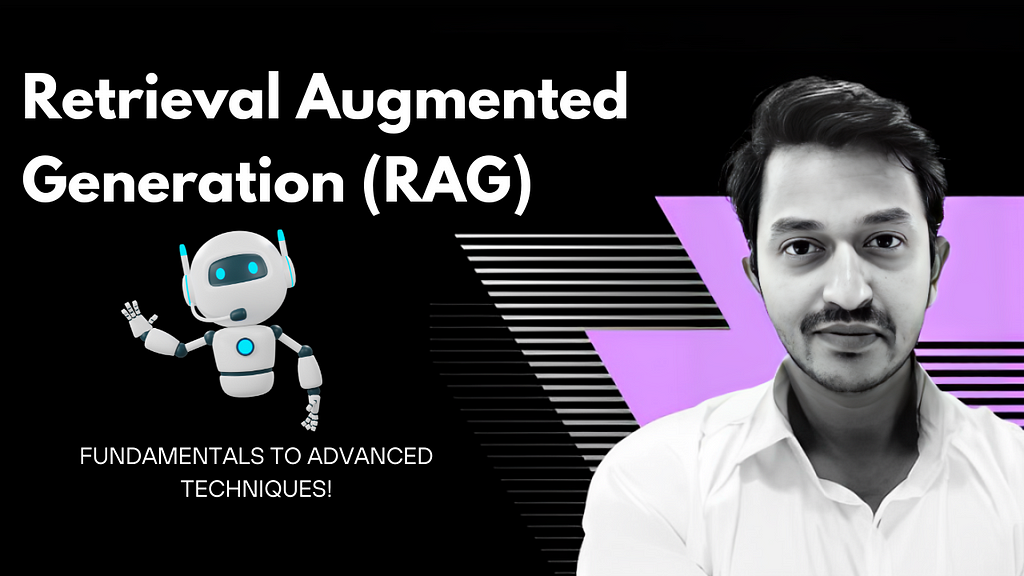
New to the world of Retrieval Augmented Generation (RAG)? We’ve got you covered with this in-depth guide.
Large language models (LLMs) are becoming the backbone of most organizations these days as the whole world is making the transition toward AI. While LLMs are all good and trending for all the positive reasons, they also pose some disadvantages if not used properly. Yes, LLMs can sometimes produce the responses that aren’t expected, they can be fake, made up information or even biased. Now, this can happen for various reasons. We call this process of generating misinformation by LLMs as hallucination.
There are some notable approaches to mitigate the LLM hallucinations such as fine-tuning, prompt engineering, retrieval augmented generation (RAG) etc. Retrieval augmented generation (RAG) has been the most talked about approach in mitigating the hallucinations faced by large language models. Today, we will see everything about the RAG approach, what it is, how it works, its components, and workflow from basic to advanced.
What is RAG
Retrieval-Augmented Generation (RAG) is a natural language processing framework that enhances large language models (LLMs) by integrating external data retrieval with text generation. It retrieves relevant information from external sources/databases/custom source to improve response accuracy and relevance, mitigating issues like misinformation and outdated knowledge in generated content. So, RAG basically reduces the LLM hallucinations by providing contextually relevant responses through the data sources provided/attached.
RAG Components
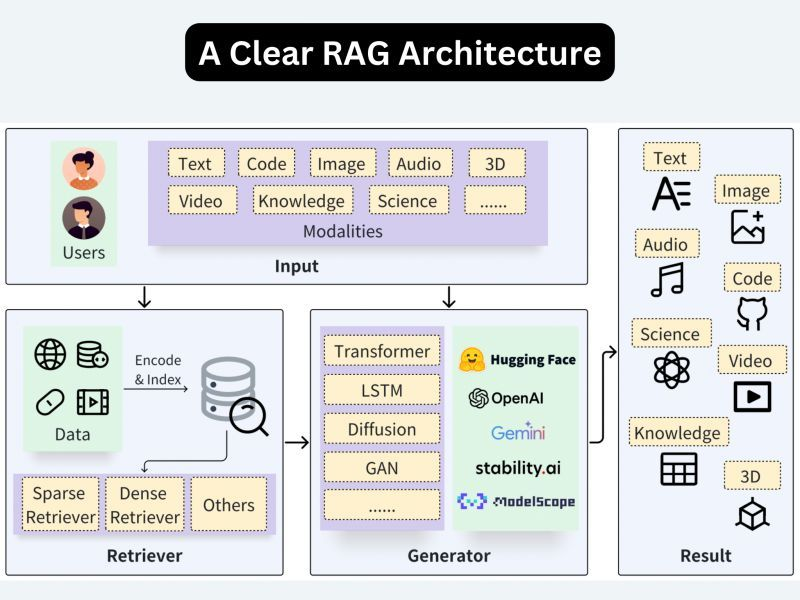
The RAG pipeline basically involves three critical components: Retrieval component, Augmentation component, and Generation component.
- Retrieval: This component helps you fetch the relevant information from the external knowledge base, like a vector database, for any given user query. This component is very crucial as this is the first step in curating meaningful and contextually correct responses.
- Augmentation: This part involves enhancing and adding more relevant context to the retrieved response for the user query.
- Generation: Finally, a final output is presented to the user with the help of a large language model (LLM). The LLM uses its own knowledge and the provided context and comes up with an apt response to the user’s query.
Advantages of Retrieval Augmented Generation
There are some incredible advantages of RAG. Let me share some notable ones:
- Scalability. RAG approach helps you with scale models by simply updating or adding external/custom data to your external database (vector database).
- Memory efficiency. Traditional models like GPT have limits when it comes to pulling fresh and updated information and fail to be memory efficient. RAG leverages external databases like a vector database, allowing it to pull in fresh, updated, or detailed information quickly when needed.
- Flexibility. By updating or expanding the external knowledge source, you can adapt RAG to build any AI applications with flexibility.
Systematic RAG Workflow
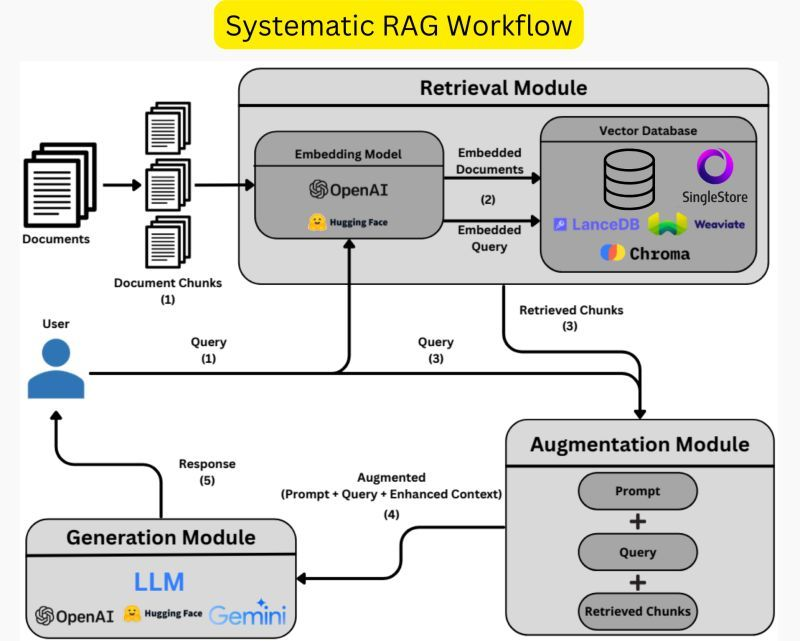
RAG consists of three modules that you need to understand!
Retrieval module, Augmentation module, and Generation module (as discussed above).
First, the document which forms the source database is divided into chunks. These chunks, transformed into vectors using an embedding model like OpenAI or open source models available from the Hugging Face community, are then embedded into a high-dimensional vector database (e.g., SingleStore Database, Chroma, and LlamaIndex).
When the user inputs a query, the query is embedded into a vector using the same embedding model. Then, chunks whose vectors are closest to the query vector, based on some similarity metrics (e.g., cosine similarity) are retrieved. This process is contained in the retrieval module shown in the figure. After that, the retrieved chunks are augmented to the user’s query and the system prompt in the augmentation module.
This step is critical for making sure that the records from the retrieved documents are effectively incorporated with the query. Then, the output from the augmentation module is fed to the generation module, which is responsible for generating an accurate answer to the query by utilizing the retrieved chunks and the prompt through an LLM (like chatGPT by OpenAI, hugging face, and Gemini by Google).
But to make RAG work perfectly, here are some key points to consider:
1. Quality of External Knowledge Source: The quality and relevance of the external knowledge source used for retrieval are crucial.
2. Embedding Model: The choice of the embedding model used for retrieving relevant documents or passages from the knowledge source is important.
3. Chunk Size and Retrieval Strategy: Experiment with different chunk sizes to find the optimal length for context retrieval. Larger chunks may provide more context but could also introduce irrelevant information. Smaller chunks may focus on specific details but might lack broader context.
4. Integration with Language Model: The way the retrieved information is integrated with the language model’s generation process is crucial. Techniques like cross-attention or memory-augmented architectures can be used to effectively incorporate the retrieved information into the model’s output.
5. Evaluation and Fine-tuning: Evaluating the performance of the RAG model on relevant datasets and tasks is important to identify areas for improvement. Fine-tuning the RAG model on domain-specific or task-specific data can further enhance its performance.
6. Ethical Considerations: Ensure that the external knowledge source is unbiased and does not contain offensive or misleading information.
7. Handling Out-of-Date or Incorrect Information: It’s important to have strategies in place for handling situations where the retrieved information is out-of-date or incorrect.
Use SingleStore Database as your vector store, try for free: https://bit.ly/SingleStoreDB
RAG Retrieval Sources
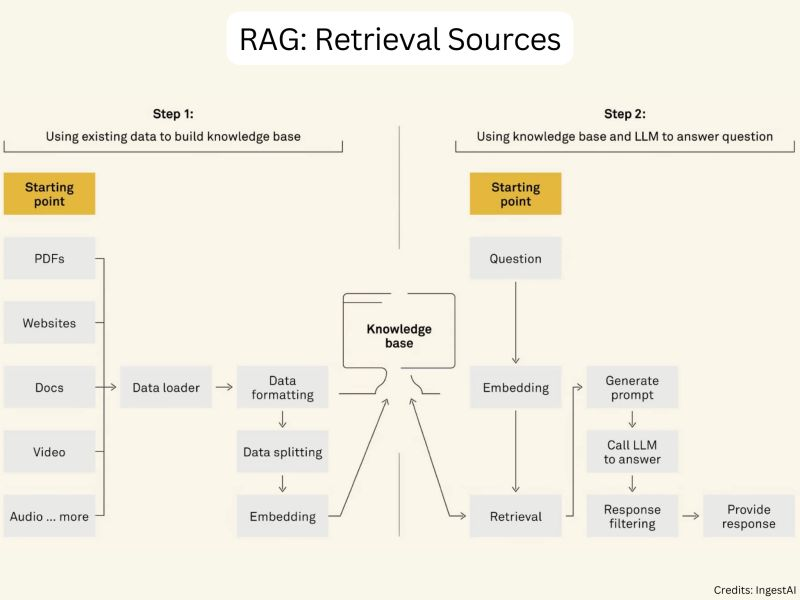
Do you know how RAG applications acquire external knowledge?
RAG systems can leverage various types of retrieval sources to acquire external knowledge.
The most common data types include:
⮕ Unstructured Data (Text): This includes plain text documents, web pages, and other free-form textual sources.
⮕ Semi-Structured Data (PDF): PDF documents, such as research papers, reports, and manuals, contain a mix of textual and structural information.
⮕ Structured Data (Knowledge Graphs): Knowledge graphs, such as Wikipedia and Freebase, represent information in a structured and interconnected format.
⮕ LLM-Generated Content: Recent advancements have shown that LLMs themselves can generate high-quality content that can be used as a retrieval source. This approach leverages the knowledge captured within the LLM’s parameters to generate relevant information.
All this data gets converted into embeddings and gets stored in a vector database. When a user query comes in, it also gets converted into an embedding (query embedding) and the most relevant answer will be retrieved using semantic search. The vector database becomes knowledge base to search for the contextually relevant answer.
Additionally, one more aspect to consider is retrieval granularity. It refers to the level at which knowledge is retrieved from the sources.
Common levels of retrieval granularity include:
⮕ Phrase-Level Retrieval: This involves retrieving short phrases or snippets of text that are highly relevant to the query. Phrase-level retrieval can provide precise and targeted information but may lack broader context.
⮕ Sentence-Level Retrieval: Sentence-level retrieval focuses on retrieving complete sentences that contain relevant information. It strikes a balance between specificity and context, making it suitable for a wide range of tasks.
⮕ Chunk-Level Retrieval: Chunk-level retrieval involves retrieving larger chunks of text, such as paragraphs or sections. It provides more comprehensive information and context but may introduce noise and irrelevant details.
⮕ Document-Level Retrieval: Document-level retrieval retrieves entire documents that are relevant to the query. While it offers the most extensive context, it may require additional processing to extract the most pertinent information.
Know more about knowledge retrieval in RAG: https://ingestai.io/blog/knowledge-retrieval-in-rag
RAG Tutorial
Let’s build a simple AI application that can fetch the contextually relevant information from our own data for any given user query.
Follow the complete hands-on tutorial from my Medium article.
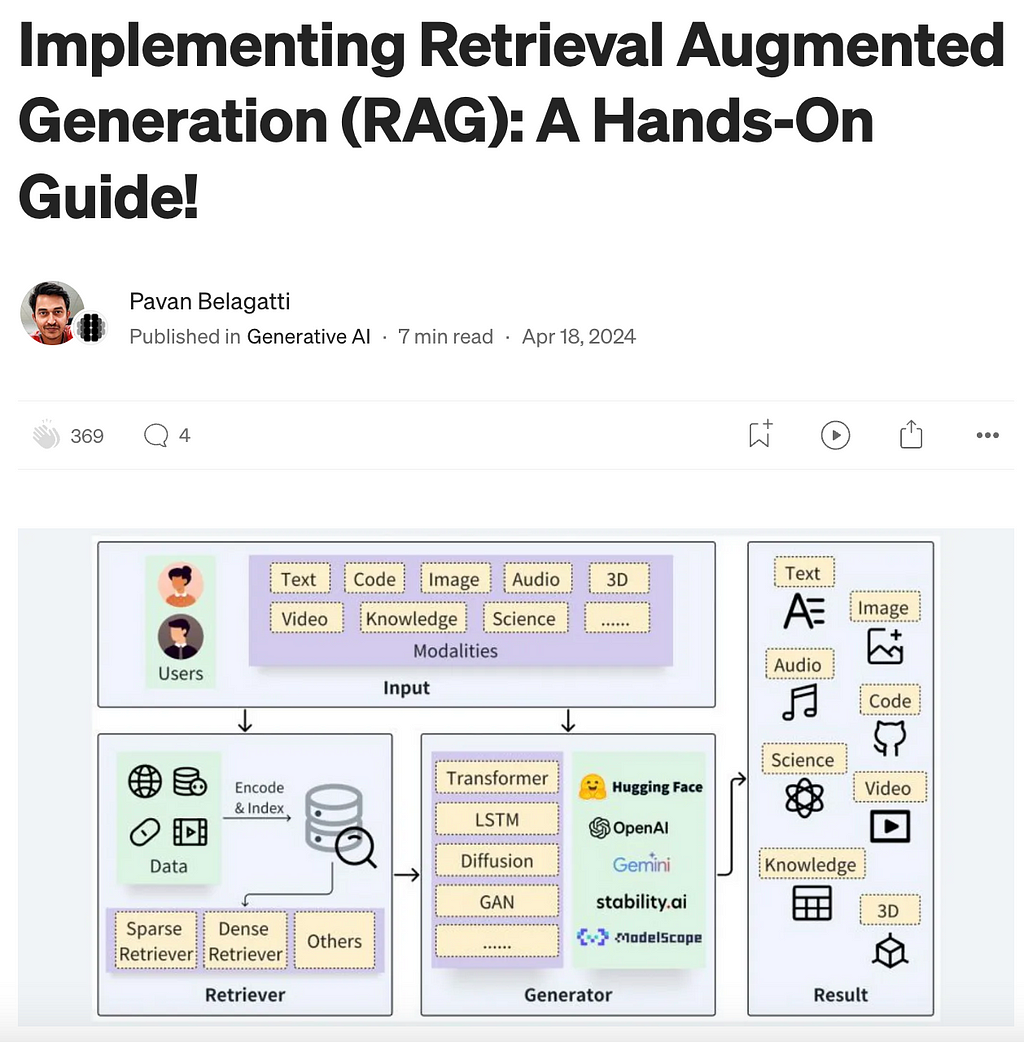
Evolution of RAG Over Time
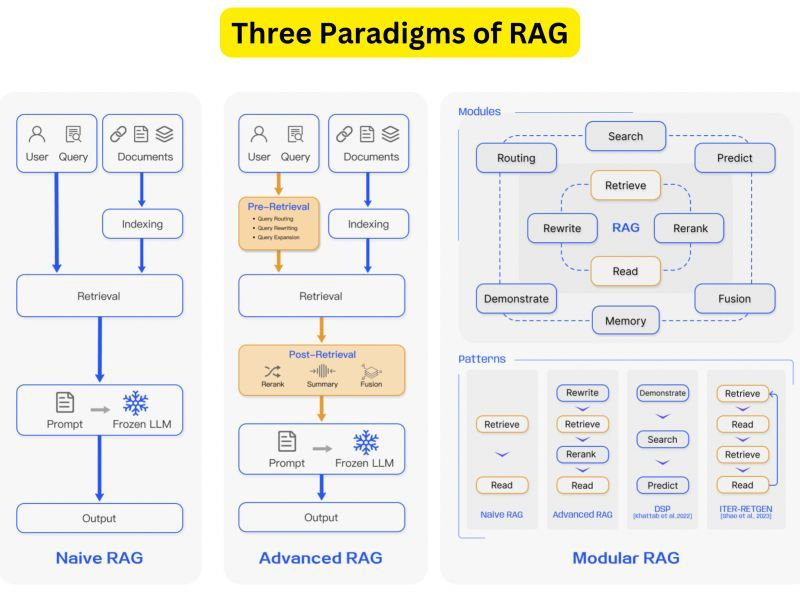
Let’s talk about the RAG evolution over time.
1. Naive RAG:
The Naive RAG research paradigm represents the earliest methodology, which gained prominence shortly after the widespread adoption of ChatGPT. The Naive RAG follows a traditional process that includes indexing, retrieval, and generation. It is also characterized as a “Retrieve-Read” framework [Ma et al., 2023a].
2. Advanced RAG:
Advanced RAG has been developed with targeted enhancements to address the shortcomings of Naive RAG. In terms of retrieval quality, Advanced RAG implements pre-retrieval and post-retrieval strategies. To address the indexing challenges experienced by Naive RAG, Advanced RAG has refined its indexing approach using techniques such as sliding window, fine-grained segmentation, and metadata. It has also introduced various methods to optimize the retrieval process [ILIN, 2023].
3. Modular RAG:
The modular RAG structure diverges from the traditional Naive RAG framework, providing greater versatility and flexibility. It integrates various methods to enhance functional modules, such as incorporating a search module for similarity retrieval and applying a fine-tuning approach in the retriever [Lin et al., 2023].
Restructured RAG modules [Yu et al., 2022] and iterative methodologies like [Shao et al., 2023] have been developed to address specific issues. The modular RAG paradigm is increasingly becoming the norm in the RAG domain, allowing for either a serialized pipeline or an end-to-end training approach across multiple modules.
This comprehensive review paper offers a detailed examination of the progression of RAG paradigms, encompassing the Naive RAG, the Advanced RAG, and the Modular RAG.
Access the paper here: https://arxiv.org/abs/2312.10997
RAG Design Choices
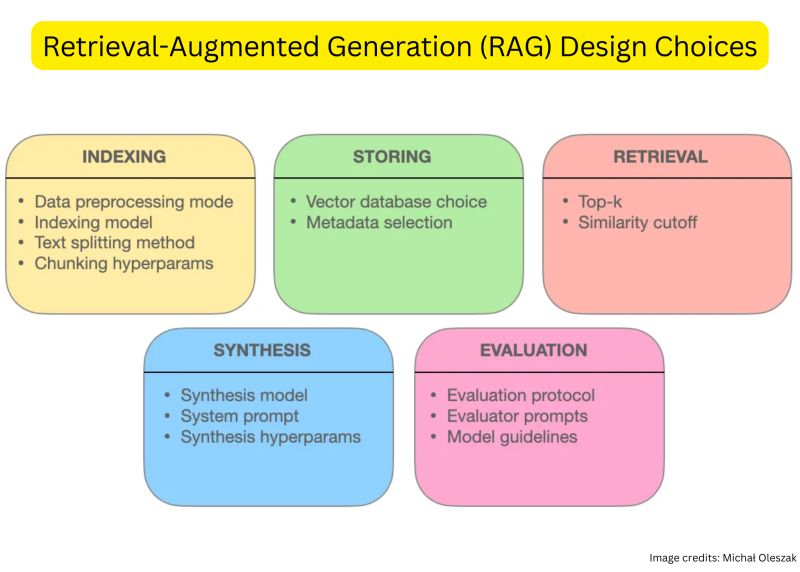
Let’s discuss some useful list of RAG design choices.
RAG basically consists of five main pieces/components:
➟ Indexing: Embedding external data into a vector representation.
➟ Storing: Persisting the indexed embeddings in a database.
➟ Retrieval: Finding relevant pieces in the stored data.
➟ Synthesis: Generating answers to user’s queries.
➟ Evaluation: Quantifying how good the RAG system is.
When designing the indexing step, there are a few design choices to make:
• Data processing mode
• Indexing model
• Text splitting method
• Chunking hyperparameters
The best embedding models might be different than the best LLMs in general.
When designing the storing step of a RAG pipeline, the two most important decisions are:
• Database choice
• Metadata selection
Sometimes finding a vector database might be very confusing due to so many databases available today. SingleStore database started supporting vector storage long back in 2017 itself. I would highly recommend choosing SingleStore as your vector database for all your AI/ML applications.
[ Try SingleStore for free: https://bit.ly/SingleStoreDB ]
There are a few things you would need to think about when designing the retrieval step:
• Retrieval strategy
• Retrieval hyperparameters
• Query transformations
The most important aspects of the evaluation step are:
• Evaluation protocol
• Evaluator prompts
• Model guidelines
Know in detail about each step and useful considerations in this original guide: https://towardsdatascience.com/designing-rags-dbb9a7c1d729
Chunking Strategies in RAG
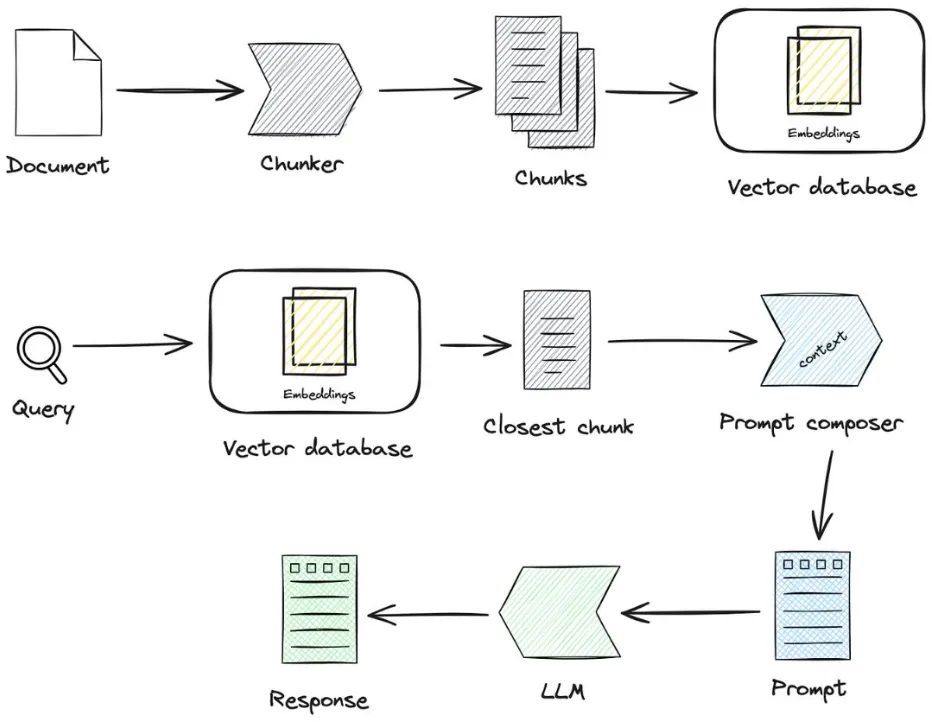
Improving the efficiency of LLM applications via RAG is all great.
BUT the question is, what should be the right chunking strategy?
Chunking is the method of breaking down the large files into more manageable segments/chunks so the LLM applications can get proper context and the retrieval can be easy.
In a video on YouTube, Greg Kamradt provides overview of different chunking strategies. Let’s understand them one by one.
They have been classified into five levels based on the complexity and effectiveness.
⮕ Level 1 : Fixed Size Chunking
This is the most crude and simplest method of segmenting the text. It breaks down the text into chunks of a specified number of characters, regardless of their content or structure.Langchain and llamaindex framework offer CharacterTextSplitter and SentenceSplitter (default to spliting on sentences) classes for this chunking technique.
⮕ Level 2: Recursive Chunking
While Fixed size chunking is easier to implement, it doesn’t consider the structure of text. Recursive chunking offers an alternative. In this method, we divide the text into smaller chunk in a hierarchical and iterative manner using a set of separators. Langchain framework offers RecursiveCharacterTextSplitter class, which splits text using default separators (“\n\n”, “\n”, “ “,””)
⮕ Level 3 : Document Based Chunking
In this chunking method, we split a document based on its inherent structure. This approach considers the flow and structure of content but may not be as effective documents lacking clear structure.
⮕ Level 4: Semantic Chunking
All above three levels deals with content and structure of documents and necessitate maintaining constant value of chunk size. This chunking method aims to extract semantic meaning from embeddings and then assess the semantic relationship between these chunks. The core idea is to keep together chunks that are semantic similar.Llamindex has SemanticSplitterNodeParse class that allows to split the document into chunks using contextual relationship between chunks.
⮕ Level 5: Agentic Chunking
This chunking strategy explore the possibility to use LLM to determine how much and what text should be included in a chunk based on the context.
Know more about these chunking strategies in this article.
RAG Using LangChain
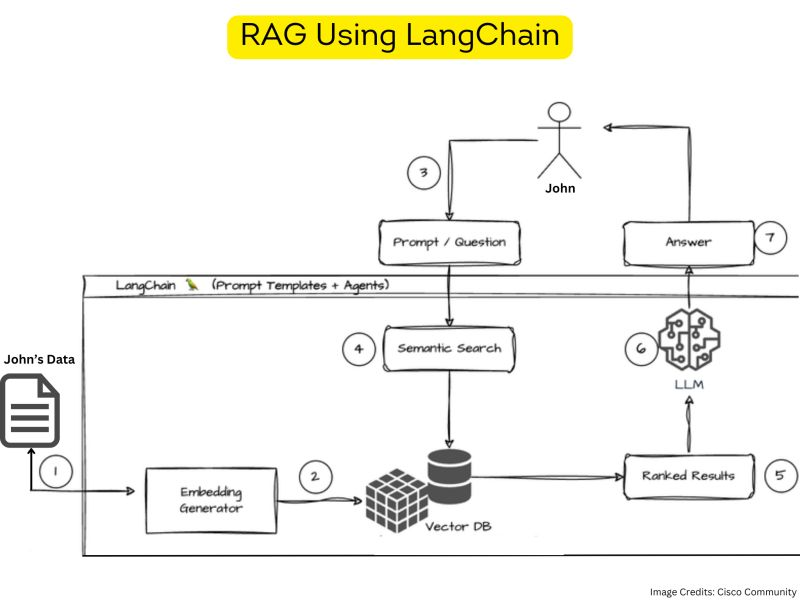
LangChain is a powerful framework for LLM-powered applications.
1. It provides a standard interface for chains, enabling developers to create sequences of calls that go beyond a single LLM call.
2. Langchain allows developers to build chatbots, generative question-answering systems, summarization tools, and more.
3. It simplifies the process of working with LLMs and provides tools for prompt management, memory, indexing, and agent-based decision-making.
4. Langchain is designed to be data-aware and agentic, connecting language models to other data sources and allowing them to interact with their environment.
Let’s see the how RAG works using LangChain.
1. Documents are converted into a vector representation, often referred to as an embedding.
2. Embeddings (vectorized documents) are stored in a vector database
3. The user asks a question.
4. Once the data is stored in the database, Langchain supports various retrieval algorithms. These include basic semantic search, parent document retriever, self-query retriever, ensemble retriever, and more.
5. When conducting a search, the retrieval system assigns a score or ranking to each document based on its relevance to the query.
6. Results are sent to the LLM
7. Leveraging the contextual representation, the model then generates a response.
Wanna do a hands-on tutorial?
Here is my guide on implementing RAG using LangChain: A Step-by-Step Guide — https://levelup.gitconnected.com/implementing-rag-using-langchain-and-singlestore-a-step-by-step-guide-2a579da1de0c
Advanced RAG
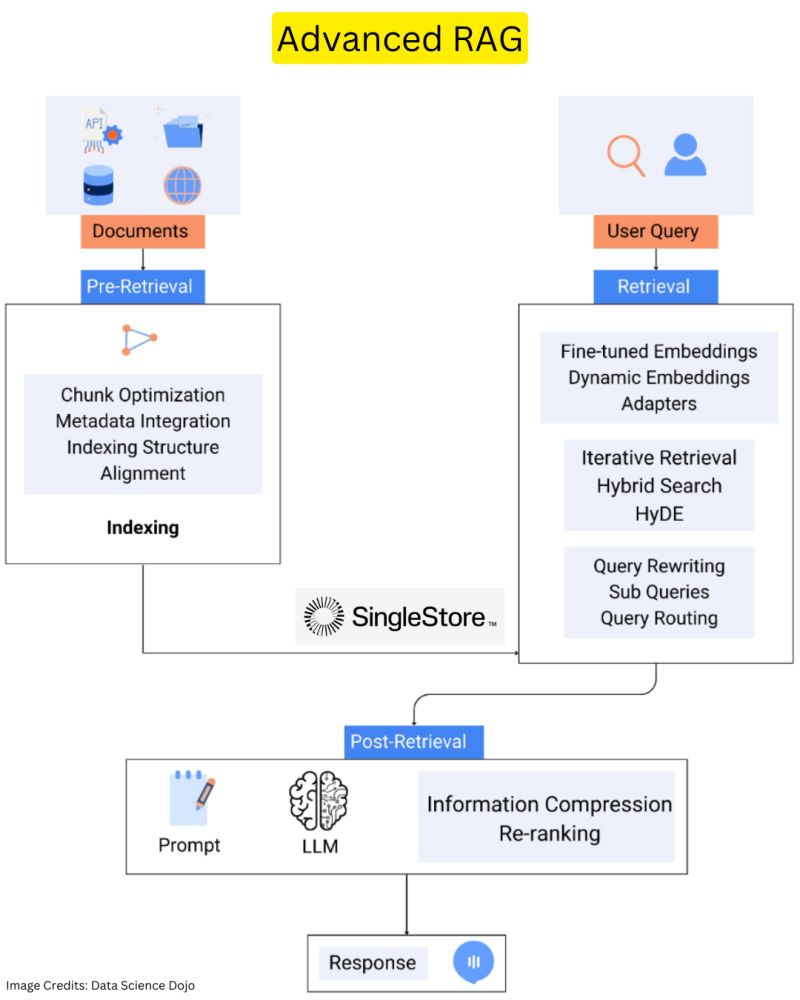
Let’s use some simple query examples from the basic RAG explanation: “What’s the latest breakthrough in renewable energy?”, to better understand these advanced techniques.
⮕ Pre-retrieval optimizations: Before the system begins to search, it optimizes the query for better outcomes. For our example, Query Transformations and Routing might break down the query into sub-queries like “latest renewable energy breakthroughs” and “new technology in renewable energy.”
This ensures the search mechanism is fine-tuned to retrieve the most accurate and relevant information.
⮕ Enhanced retrieval techniques: During the retrieval phase, Hybrid Search combines keyword and semantic searches, ensuring a comprehensive scan for information related to our query. Moreover, by Chunking and Vectorization, the system breaks down extensive documents into digestible pieces, which are then vectorized.
This means our query doesn’t just pull up general information but seeks out the precise segments of texts discussing recent innovations in renewable energy.
⮕ Post-retrieval refinements: After retrieval, Reranking and Filtering processes evaluate the gathered information chunks. Instead of simply using the top ‘k’ matches, these techniques rigorously assess the relevance of each piece of retrieved data. For our query, this could mean prioritizing a segment discussing a groundbreaking solar panel efficiency breakthrough over a more generic update on solar energy.
This step ensures that the information used in generating the response directly answers the query with the most relevant and recent breakthroughs in renewable energy.
Know more in the original article: https://datasciencedojo.com/blog/rag-vs-finetuning-llm-debate/
Reranking in RAG
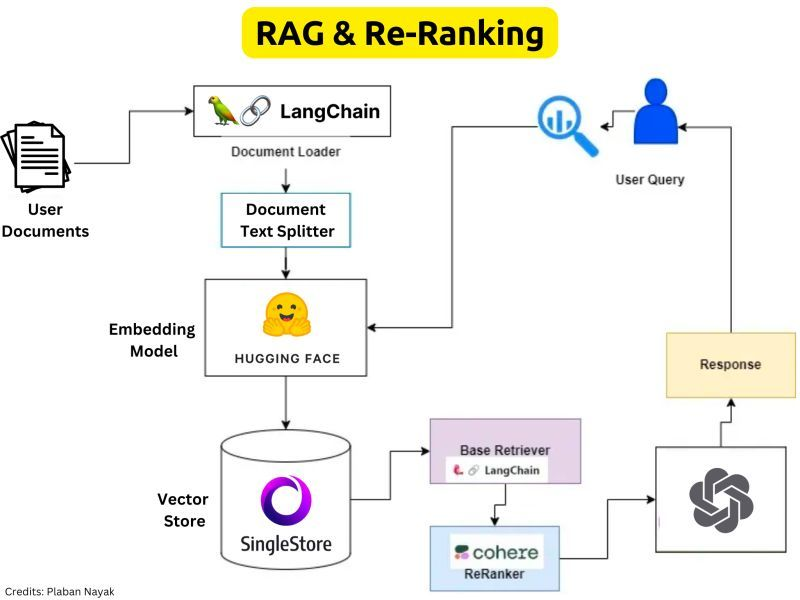
Traditional semantic search consists of a two-part process.
First, an initial retrieval mechanism does an approximate sweep over a collection of documents and creates a document list.
Then, a re-ranker mechanism will take this candidate document list and re-rank the elements. With Rerank, we can improve your models by re-organizing your results based on certain parameters.
Why is Re-Ranking Required ?
⮕ The recall performance for LLMs decreases as we add more context resulting in increased context window(context stuffing)
⮕ Basic Idea behind reranking is to filter down the total number of documents into a fixed number .
⮕ The re-ranker will re-rank the records and get the most relevant items at the top and they can be sent to the LLM
⮕ The Reranking offers a solution by finding those records that may not be within the top 3 results and put them into a smaller set of results that can be further fed into the LLM
Reranking basically enhance the relevance and precision of retrieved results.
Know more in this article: https://medium.aiplanet.com/advanced-rag-cohere-re-ranker-99acc941601c
Types of Embedding Models for RAG
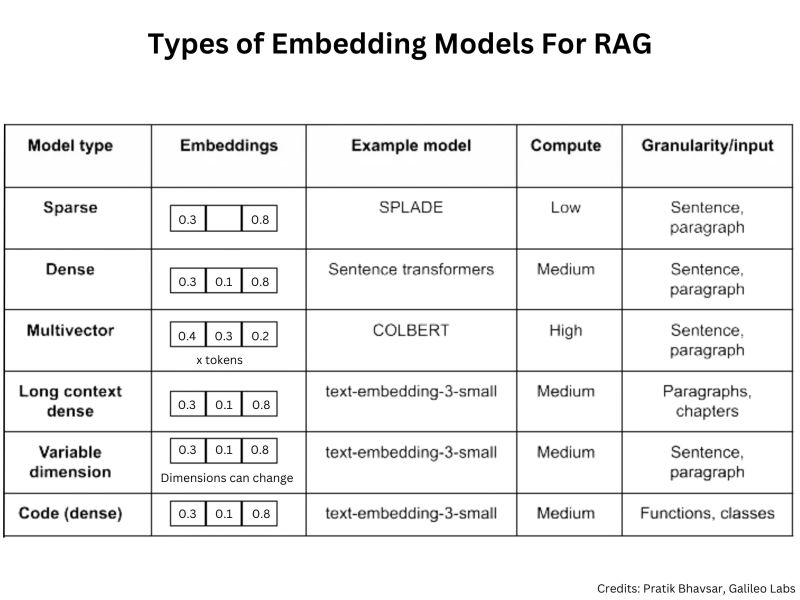
How to Select an Embedding Model for Your RAG Application?
Embeddings form the foundation for achieving precise and contextually relevant LLM outputs across different tasks.
Which encoder you select to generate embeddings is a critical decision, hugely impacting the overall success of the RAG system. Low quality embeddings lead to poor retrieval.
When selecting an embedding model, consider the vector dimension, average retrieval performance, and model size.
Companies such as OpenAI, Cohere, and Voyage consistently release enhanced embedding models.
Different types of embeddings are designed to address unique challenges and requirements in different domains.
⮕ Dense embeddings are continuous, real-valued vectors that represent information in a high-dimensional space. In the context of RAG applications, dense embeddings, such as those generated by models like OpenAI’s Ada or sentence transformers, contain non-zero values for every element.
⮕ Sparse embeddings, on the other hand, are representations where most values are zero, emphasizing only relevant information. In RAG applications, sparse vectors are essential for scenarios with many rare keywords or specialized terms.
⮕ Multi-vector embedding models like ColBERT feature late interaction, where the interaction between query and document representations occurs late in the process, after both have been independently encoded.
⮕ Long documents have always posed a particular challenge for embedding models. The limitation on maximum sequence lengths, often rooted in architectures like BERT, leads to practitioners segmenting documents into smaller chunks. Unfortunately, this segmentation can result in fragmented semantic meanings and misrepresentation of entire paragraphs.
⮕ Variable dimension embeddings are a unique concept built on Matryoshka Representation Learning (MRL). MRL learns lower-dimensional embeddings that are nested into the original embedding, akin to a series of Matryoshka Dolls.
⮕ Code embeddings are a recent development used to integrate AI-powered capabilities into Integrated Development Environments (IDEs), fundamentally transforming how developers interact with codebases.
There are several factors that need to be considered while selecting an embedding model.
Know more about embeddings and models in this article: https://www.rungalileo.io/blog/mastering-rag-how-to-select-an-embedding-model
No matter which embedding model you use, having a robust database is a must for your RAG application.
Use SingleStore as your vector database to build your AI/ML apps. Sign up & use for free: https://bit.ly/SingleStoreDB
Semantic Chunking in RAG Applications
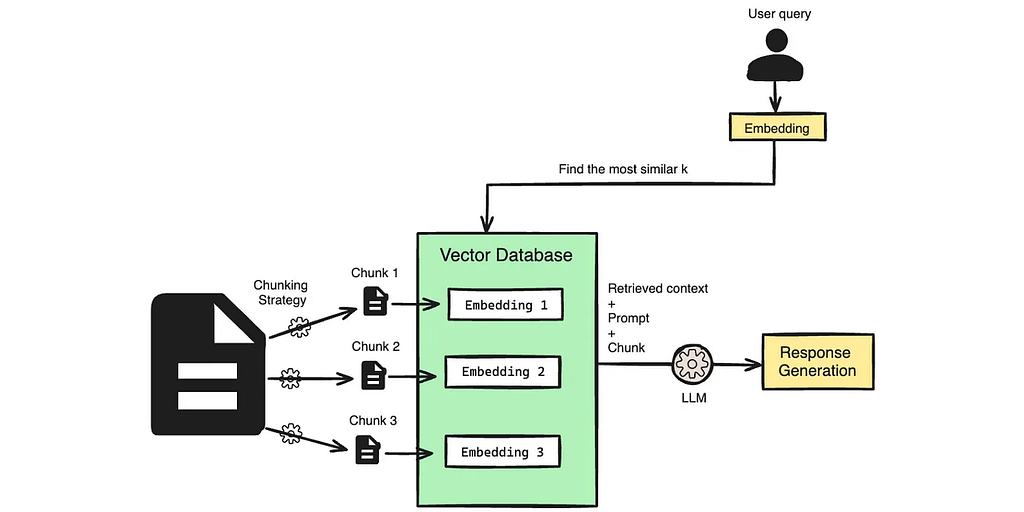
Chunking in RAG applications involves breaking down large pieces of data into smaller, manageable segments or “chunks.” This process enhances the efficiency and accuracy of information retrieval by enabling the model to handle more precise and relevant portions of data.
In RAG systems, when a query is made, the model searches through these chunks to find the most relevant information, rather than going through an entire document.
This not only speeds up the retrieval process but also improves the quality of the generated responses by focusing on the most pertinent information.
Chunking is especially useful in scenarios where documents are lengthy or contain diverse topics, as it ensures that the retrieved data is contextually appropriate and precise.
Naive chunking strategies limit themselves with dividing the text into chunks of a fixed number of words or characters, and not always effective.
Semantic Chunking is a method that focuses on extracting and preserving the semantic meaning within text segments. By utilizing embeddings to capture the underlying semantics, this approach assesses the relationships between different chunks to ensure that similar content is kept together.
By focusing on the text’s meaning and context, Semantic Chunking significantly enhances retrieval quality. It’s ideal for maintaining semantic integrity, ensuring coherent and relevant information retrieval.
Let’s see how semantic chunking is better than your naive chunking strategies in my tutorial: https://levelup.gitconnected.com/semantic-chunking-for-enhanced-rag-applications-b6bc92942af0
Retrieval Pain Points in RAG
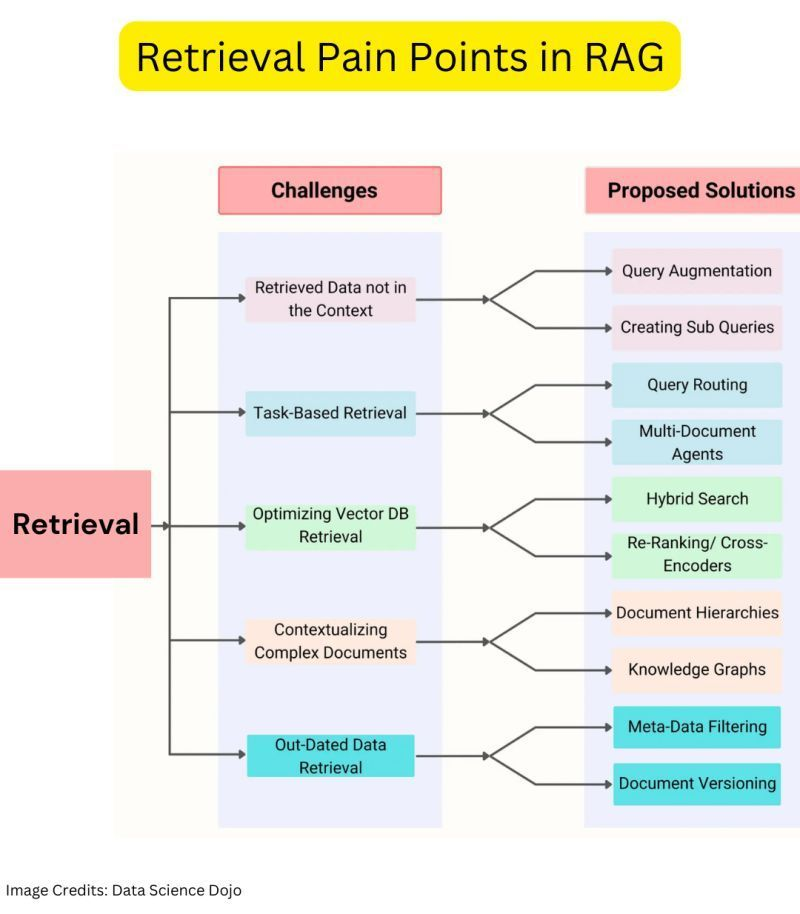
The approach of RAG might not be as easy as you think.
Effective retrieval is a pain, and you can encounter several issues during this important stage.
Here are some common pain points and possible solutions in the retrival stage.
⮕ Challenge: Retrieved data not in context & there can be several reasons for this.
➤ Missed Top Rank Documents: The system sometimes doesn’t include essential documents that contain the answer in the top results returned by the system’s retrieval component.
➤ Incorrect Specificity: Responses may not provide precise information or adequately address the specific context of the user’s query
➤ Losing Relevant Context During Reranking: This occurs when documents containing the answer are retrieved from the database but fail to make it into the context for generating an answer.
⮕ Proposed Solutions:
➤ Query Augmentation: Query augmentation enables RAG to retrieve information that is in context by enhancing the user queries with additional contextual details or modifying them to maximize relevancy. This involves improving the phrasing, adding company-specific context, and generating sub-questions that help contextualize and generate accurate responses
- Rephrasing
- Hypothetical document embeddings
- Sub-queries
➤ Tweak retrieval strategies: Llama Index offers a range of retrieval strategies, from basic to advanced, to ensure accurate retrieval in RAG pipelines. By exploring these strategies, developers can improve the system’s ability to incorporate relevant information into the context for generating accurate responses.
- Small-to-big sentence window retrieval,
- recursive retrieval
- semantic similarity scoring.
➤ Hyperparameter tuning for chunk size and similarity_top_k: This solution involves adjusting the parameters of the retrieval process in RAG models. More specifically, we can tune the parameters related to chunk size and similarity_top_k.
The chunk_size parameter determines the size of the text chunks used for retrieval, while similarity_top_k controls the number of similar chunks retrieved.
By experimenting with different values for these parameters, developers can find the optimal balance between computational efficiency and the quality of retrieved information.
➤ Reranking: Reranking retrieval results before they are sent to the language model has proven to improve RAG systems’ performance significantly.
This reranking process can be implemented by incorporating the reranker as a postprocessor in the RAG pipeline.
Know more about the other pain points & possible solutions explained in detail: https://datasciencedojo.com/blog/rag-challenges-in-llm-applications/
RAG Enhancement Techniques
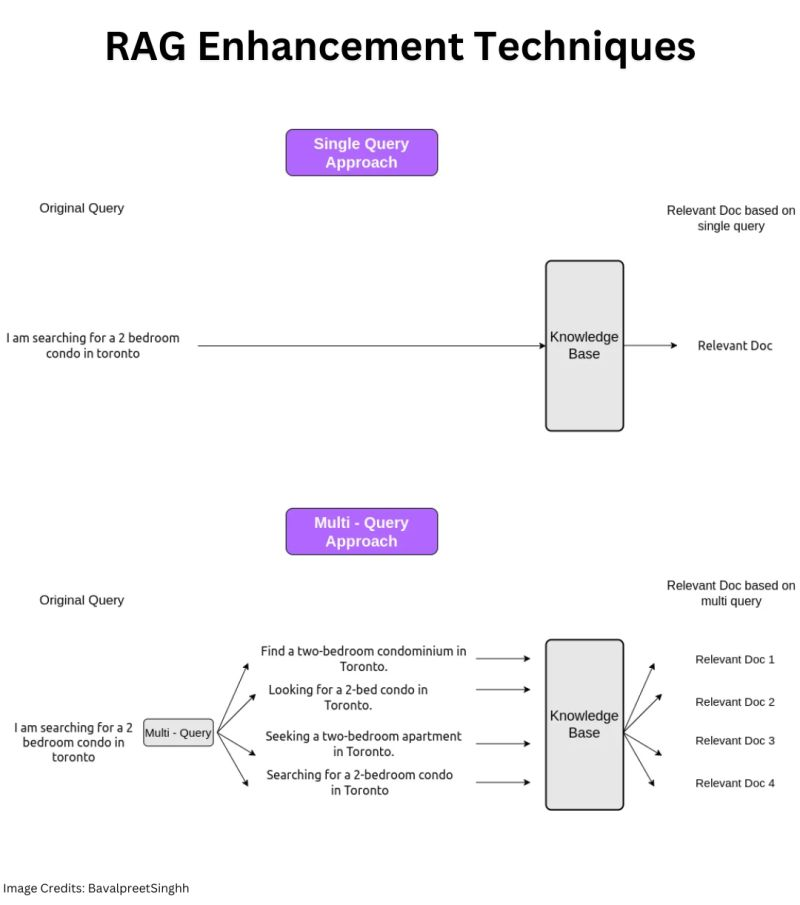
The road to building RAG applications is not a smooth one.
You need to know some techniques to overcome different challenges that RAG throws at you while building LLM powered applications.
1. Transformation from Single Query to Multi Query:
Multi-Query is an advanced approach in the Query Transformation stage of retrieval. Unlike traditional methods where only one query is used, Multi-Query generates multiple queries and retrieves similar documents for each one. Builders utilize Multi-Query primarily for two reasons: enhancing suboptimal queries and expanding result sets. It addresses users’ imperfect queries by filling in gaps and retrieves more diverse results, leading to an expanded results set that can provide better answers than single-query documents.
2. Improving Indexed Data Quality:
Unfortunately, data cleaning is often overlooked during the development of RAGs, with a tendency to ingest all available documents without verifying their quality. We need to ensure that the data fed into the RAG system is of high quality for obtaining accurate answers. The principle of “garbage in, garbage out” is especially relevant here.
3. Chunking strategy and size matters to optimize index structure:
When setting up your Retrieval Augmented Generation (RAG) system, the size of the chunks and chunking technique plays a crucial role. It determines how much information is retrieved from the document store for processing. Choosing a small chunk size may lead to missing important details, while opting for a larger size could introduce irrelevant information.
4. Incorporation of metadata with indexed vectors:
Adding metadata alongside indexed vectors in the vector database offers significant benefits in organizing and enhancing search relevance.
5. Improving search relevance with question-based indexing:
LLMs and RAGs offer incredible power by allowing users to express queries in natural language, simplifying data exploration and complex tasks. However, a common challenge arises when there’s a disconnect between the concise queries, users input and the longer, more detailed documents stored in the system.
6. Improving Search Precision with Mixed Retrieval — Hybrid Search
While vector search excels in retrieving semantically relevant chunks for queries, it sometimes lacks precision in matching specific keywords. To get the best of both the worlds, (vector search + full-text search) you need hybrid search.
Know some more techniques in this article: https://blog.stackademic.com/rag-understanding-the-concept-and-various-enhancement-techniques-608b643bf2e5
No matter what RAG technique you choose, you would always need a robust database to store your vector data, make sure to use SingleStore as your vector database.
Try SingleStore database for free: https://bit.ly/SingleStoreDB
RAG Best Practices
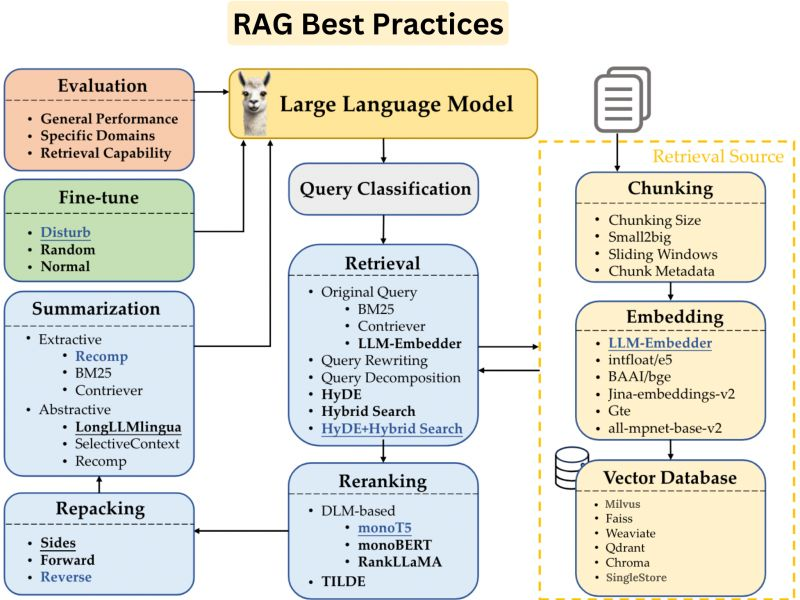
RAG Best Practices Every AI/ML/Data Engineer Should Know.
Depending on your use case, the requirements change. Whether it is about selecting a smart model, chunking strategy, embedding method and models, vector databases, evaluation techniques, AI frameworks, etc
To make RAG work perfectly, here are some key points to consider:
1. Quality of External Knowledge Source
2. Data Indexing Optimizations: Techniques such as using sliding windows for text chunking and effective metadata utilization to create a more searchable and organized index.
3. Query Enhancement: Modifying or expanding the initial user query with synonyms or broader terms to improve the retrieval of relevant documents.
4. Embedding Model: The choice of the embedding model used for retrieving relevant documents.
5. Chunk Size & Retrieval Strategy: Experiment with different chunk sizes to find the optimal length for context retrieval.
6. Integration with Language Model: The way the retrieved information is integrated with the language model’s generation process is crucial.
7. Evaluation & Fine-tuning: Evaluating the performance of the RAG model on relevant datasets and tasks is important to identify areas for improvement.
8. Ethical Considerations: Ensure that the external knowledge source is unbiased and does not contain offensive or misleading information.
9. Vector database: Having a vector database that supports fast ingestion, retrieval performance, hybrid search is utmost important.
10. Response Summarization: Condensing retrieved text to provide concise and relevant summaries before final response generation.
11. Re-ranking and Filtering: Adjusting the order of retrieved documents based on relevance and filtering out less pertinent results to refine the final output.
12. LLM models: Consider LLM models that are robust and fast enough to build your RAG application.
13. Hybrid Search: Combining traditional keyword-based search with semantic search using embedding vectors to handle a variety of query complexities.
No matter what RAG technique you choose, you would always need a robust vector database to store your vector data, make sure to use SingleStore as your vector database.
Try SingleStore database for free: https://bit.ly/SingleStoreDB
Image credits: https://arxiv.org/pdf/2407.01219
Semantic Cache to Improve RAG
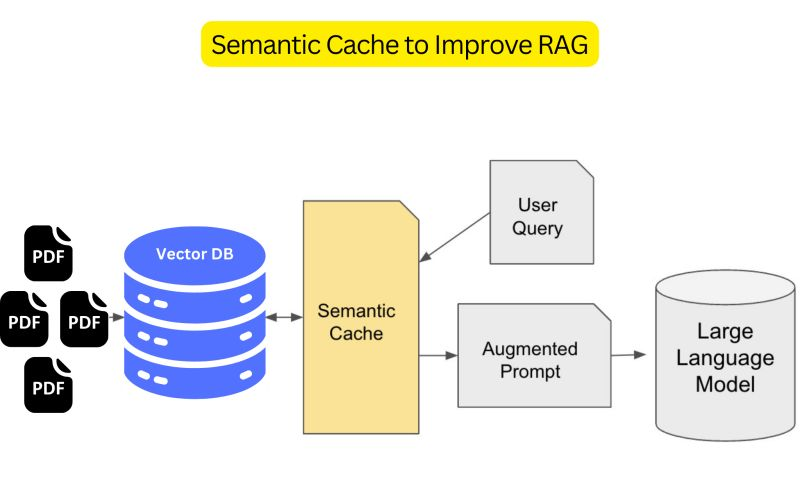
Fast retrieval is a must in RAG for today’s AI/ML applications.
Latency and computational cost are the two major challenges while deploying these applications in production.
While RAG enhances this capability to certain extent, integrating a semantic cache layer in between that will store various user queries and decide whether to generate the prompt enriched with information from the vector database or the cache is a must.
A semantic caching system aims to identify similar or identical user requests. When a matching request is found, the system retrieves the corresponding information from the cache, reducing the need to fetch it from the original source.
There are many solutions that can help you with the semantic caching but I can recommend using SingleStore database.
Why use SingleStore Database as the semantic cache layer?
SingleStoreDB is a real-time, distributed database designed for blazing fast queries with an architecture that supports a hybrid model for transactional and analytical workloads.
This pairs nicely with generative AI use cases as it allows for reading or writing data for both training and real-time tasks — without adding complexity and data movement from multiple products for the same task.
SingleStoreDB also has a built-in plancache to speed up subsequent queries with the same plan.
Know more about semantic caching with SingleStore.
Improving RAG Pipeline
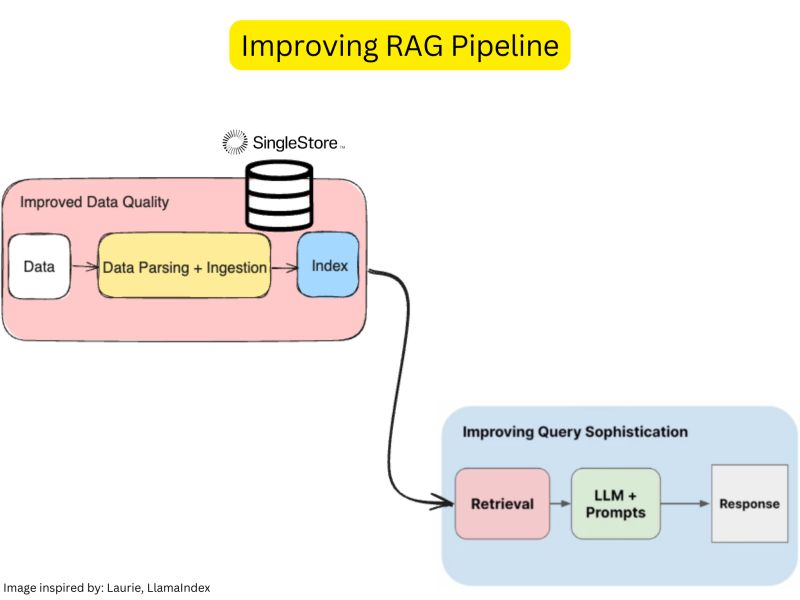
Basic RAG is limited in handling complex tasks like summarization, comparison, and multi-part questions. It is primarily useful for simple questions over small datasets but struggles with more sophisticated queries.
There are two ways you can improve your RAG pipeline.
1. Improve your data
2. Improve your querying
You can use a framework such as LlamaIndex and its toolkit to improve both.
If you are new to LlamaIndex, it is a framework in Python and TypeScript for building LLM-enabled applications over various data sources. They offer open-source tools and a paid service, Llama Cloud, for building and scaling data retrieval systems.
You can improve your data using LlamaParse. LlamaParse is an API created by LlamaIndex to efficiently parse and represent files for efficient retrieval and context augmentation using LlamaIndex frameworks.
You can use a vector database like SingleStore database to store the vector embeddings.
[ Try SingleStore for Free: https://bit.ly/SingleStoreDB ]
You can improve the quality of your data is through LlamaHub. LlamaHub :llama: This is a simple library of all the data loaders / readers that have been created by the community. The goal is to make it extremely easy to connect large language models to a large variety of knowledge sources. It includes data loaders, tools, vector databases, LLMs and more.
Then comes the agentic RAG.
Agents can enhance RAG by incorporating multi-turn interactions, query understanding, tool use, reflection, and memory, addressing the limitations of naive RAG pipelines.
Agentic RAG allows AI systems to engage in iterative reasoning — understanding the full context, gathering missing information through back-and-forth dialog, calling external data sources and APIs as needed, and stitching together multi-part solutions that address the core problem in a nuanced and tailored way.
This iterative reasoning capability is crucial for enterprises to handle complex use cases across domains. That’s why many enterprises are adopting agentic RAG over rigid regular RAG.
Components of Agentic RAG:
⮕ Routing: Uses LLM to select the best tool for a query.
⮕ Memory: Retains query history to provide context for future queries.
⮕ Query Planning: Breaks complex questions into simpler ones and aggregates the responses.
Know more about improving your RAG pipeline through this video: https://www.youtube.com/watch?v=MXPYbjjyHXc
Metrics for RAG Performance
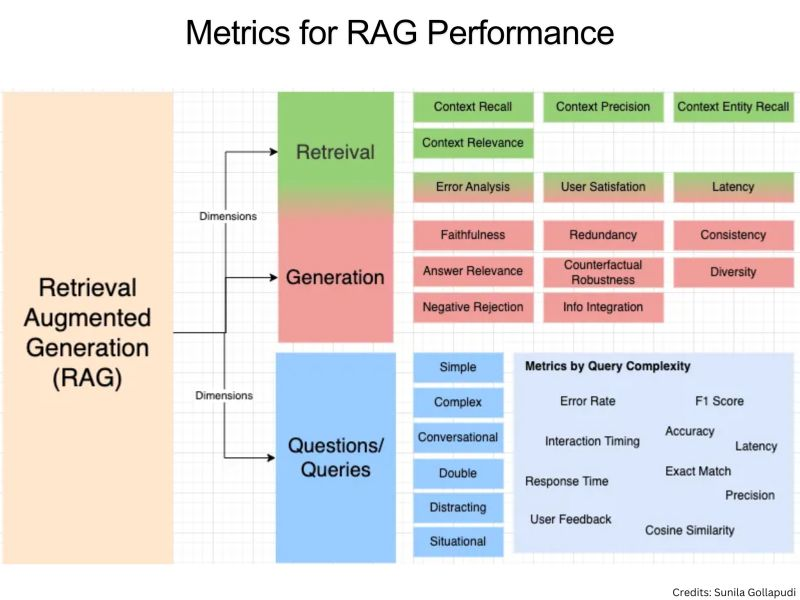
Understand some key dimensions & metrics for RAG performance.
The key dimensions for RAG (Retrieval-Augmented Generation) performance focus on both retrieval and generation aspects.
Retrieval metrics include context recall, precision, and relevance, ensuring retrieved information matches the query accurately.
Generation metrics emphasize faithfulness, relevance, and fluency of the generated text.
Key metrics like accuracy, cosine similarity, NDCG, BLEU, and F1 score evaluate overall correctness, relevance, and quality.
Operational metrics such as latency, user satisfaction, and redundancy address practical performance concerns.
Together, these metrics provide a comprehensive framework for assessing the effectiveness and reliability of RAG systems.
Also, no matter what you consider of utmost importance, having a robust data platform for fast data ingestion and retrieval. A data platform that can help you with all types of data and not just vector data.
SingleStore is one such data platform that can be used as a vector database and also for any real-time AI applications.
Try SingleStore database for free: https://bit.ly/SingleStoreDB
Know more about key dimensions & metrics for RAG performance in this article: https://sunila-gollapudi.medium.com/rag-key-aspects-for-performance-metrics-and-measurement-c41b1aa18499
RAG Approaches
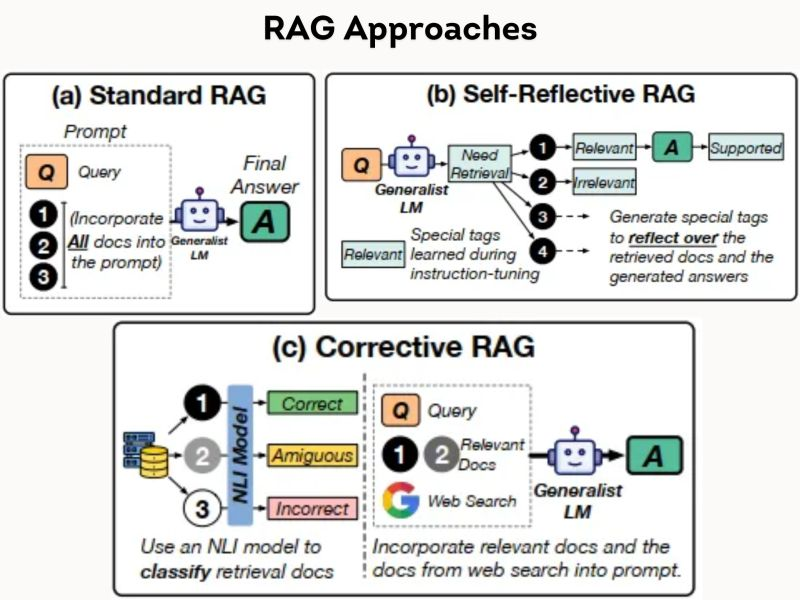
RAG is no longer just about retrieval- it’s about smart, self-improving intelligence!
We were all so excited when RAG was first introduced. We still are, this is never ending. I mean, RAG will still remain relevant for atleast a year from now (just my opinion).
So, RAG was first introduced by Meta AI researchers in 2020 through their paper — Retrieval-Augmented Generation for Knowledge-Intensive NLP Task — to address those kinds of knowledge-intensive tasks.
We saw a surge of simple to advanced RAG chatbots which is now taken over by AI agents:)
Coming to over RAG evolution over time. It all started with simple naive approach to retrieve contextually relevant responses/info and then moved on to what we call today corrective RAG.
While Standard RAG enhances response accuracy by retrieving and incorporating relevant documents into the generative process, Self-reflective RAG improves upon this by having the model assess its own outputs, tagging retrieved documents as relevant or irrelevant, and adjusting its responses accordingly.
Corrective RAG takes this a step further by using an external model to classify retrieved documents as correct, ambiguous, or incorrect, allowing the generative model to correct its answers based on this classification.
Together, these approaches represent increasing levels of refinement and accuracy in generating reliable responses.
Long live RAG!
Here is my hands-on video on RAG: https://youtu.be/TNUbBPdbsLA
Hey, here is my article on RAG you might like: https://www.singlestore.com/blog/a-guide-to-retrieval-augmented-generation-rag/
Advanced RAG Techniques
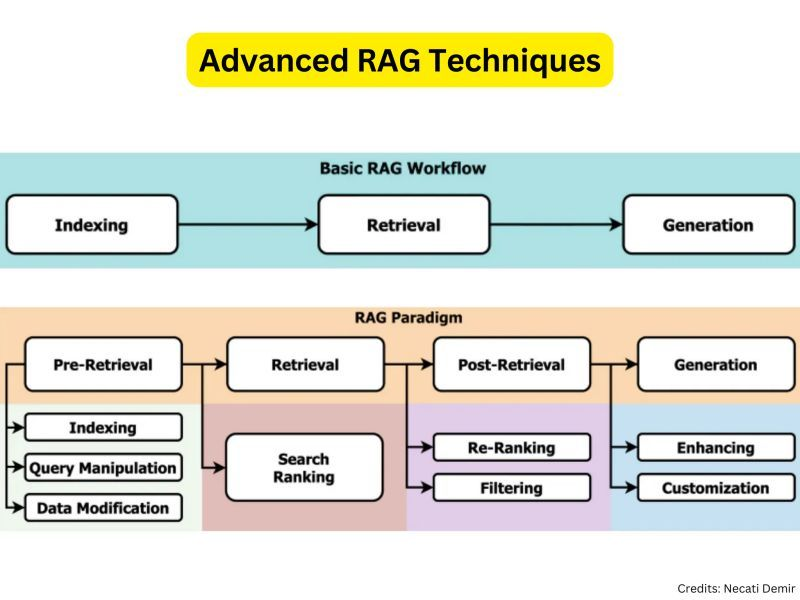
Building a simple RAG pipeline is easy. But, that doesn’t yield anything.
You need some advanced RAG techniques for your AI application.
The following is a list of enhancement points for your RAG pipeline.
⮕ Data Indexing Optimizations: Techniques such as using sliding windows for text chunking and effective metadata utilization to create a more searchable and organized index.
⮕ Query Enhancement: Modifying or expanding the initial user query with synonyms or broader terms to improve the retrieval of relevant documents.
⮕ Hybrid Search: Combining traditional keyword-based search with semantic search using embedding vectors to handle a variety of query complexities.
⮕ Fine Tuning Embedding Model: Adjusting a pre-trained model to better understand specific domain nuances, enhancing the accuracy and relevance of retrieved documents.
⮕ Response Summarization: Condensing retrieved text to provide concise and relevant summaries before final response generation.
⮕ Re-ranking and Filtering: Adjusting the order of retrieved documents based on relevance and filtering out less pertinent results to refine the final output.
Adopting a robust database that can do hybrid search, has great integration with AI frameworks, can help you will fast ingestion and vector storage is very important.
This is where SingleStore database comes handy. Sign up & use it for free: https://bit.ly/SingleStoreDB
The complete article on advanced RAG techniques by Necati Demir is here: https://blog.demir.io/advanced-rag-implementing-advanced-techniques-to-enhance-retrieval-augmented-generation-systems-0e07301e46f4
Agentic RAG Using CrewAI & LangChain
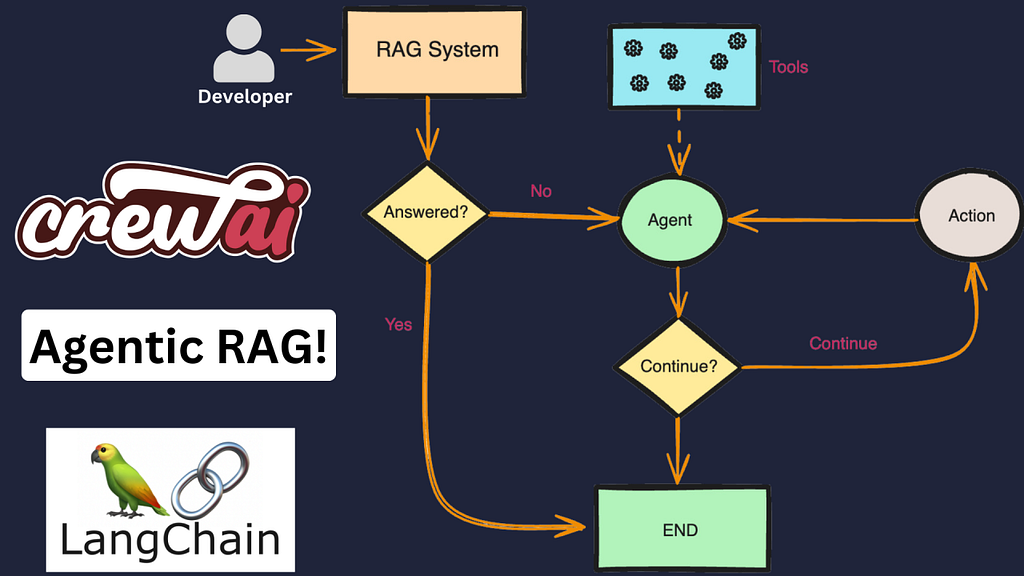
In the rapidly evolving field of artificial intelligence, Agentic RAG has emerged as a game-changing approach to information retrieval and generation. This advanced technique combines the power of Retrieval Augmented Generation (RAG) with autonomous agents, offering a more dynamic and context-aware method to process and generate information.
As businesses and researchers seek to enhance their AI capabilities, understanding and implementing Agentic RAG has become crucial to staying ahead in the competitive landscape.
This guide delves into the intricacies of mastering Agentic RAG using two powerful tools: LangChain and CrewAI. It explores the evolution from traditional RAG to its agentic counterpart, highlighting the key differences and benefits. The article also examines how LangChain serves as the foundation for implementing Agentic RAG and demonstrates the ways CrewAI can be leveraged to create more sophisticated and efficient AI systems.
Live RAG Comparison with Different Vector Databases
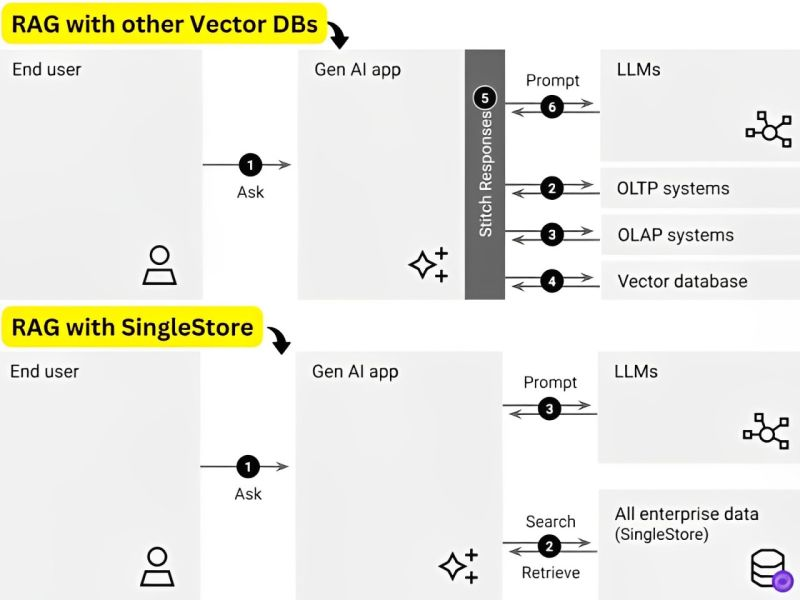
Live RAG comparison test! Let’s see who wins :trophy:
Pinecone vs Mongo vs Postgres vs SingleStore.
But first, let’s see how most of the people are implementing RAG.
See the first part of the image below, on one hand you have OLTP systems, you have your OLAP systems and now because you are vectorising your data, you have your vector systems.
So these three in combination will provide the full context to your LLM.
Let’s look at how they do that- so on the left hand side you have the end user asking a query, that query will be vectorised and that query vector will be sent to the vector database, and through vector search you will receive your top k results.
Those results along with the associated meta data will be retrieved from your OLAP and OLTP systems. Then based on the user query, will add more filters and that will then be sent to the LLM as a prompt and then the LLM answers the user question/query.
Now all of this will require a fairly complicated architecture.
And, What are the options that we have?
⮕ Pure vector databases — Pinecone, Chroma, Weaviate, Milvius, etc
⮕ Vector-capable NoSQL — MongoDB, Redis, Cassandra, etc
⮕ Vector-capable SQL — SingleStore, ROCKET, PostgreSQL, ClickHouse, etc
But then let’s also understand how does your database affect your Gen AI app?
What all you need?
- You need reliable storage
- efficient analytics
- data consistency
- vector capabilities
- scalability
- concurrency
SingleStore is built keeping all these things in mind. Let’s see how.
With SingleStore, you will have all of your transactional, analytical, and vector data co-located in one single source. So now when a end user asks a query, the GenAI app will vectorize that query, and within a single query, you can do your vector search, you can do full-text search or any other type of analytical filter you may want with miliseconds response times.
You can send all of that to the LLM as a context without any need for stitching responses together. BTW, SingleStore started supporting vectors long back in 2017 itself. The hybrid search feature adds an added advantage for your GenAI applications.
Would you like a hands-on and step-by-step guide to understand how SingleStore performs better than others?
Here is the video where one of the SingleStore engineers compared RAG with most successful DBs: https://youtu.be/xONafE5rQHk
Try SingleStore Database for free & test yourself: https://bit.ly/SingleStoreDB
RAG Setup Evaluation Using LlamaIndex
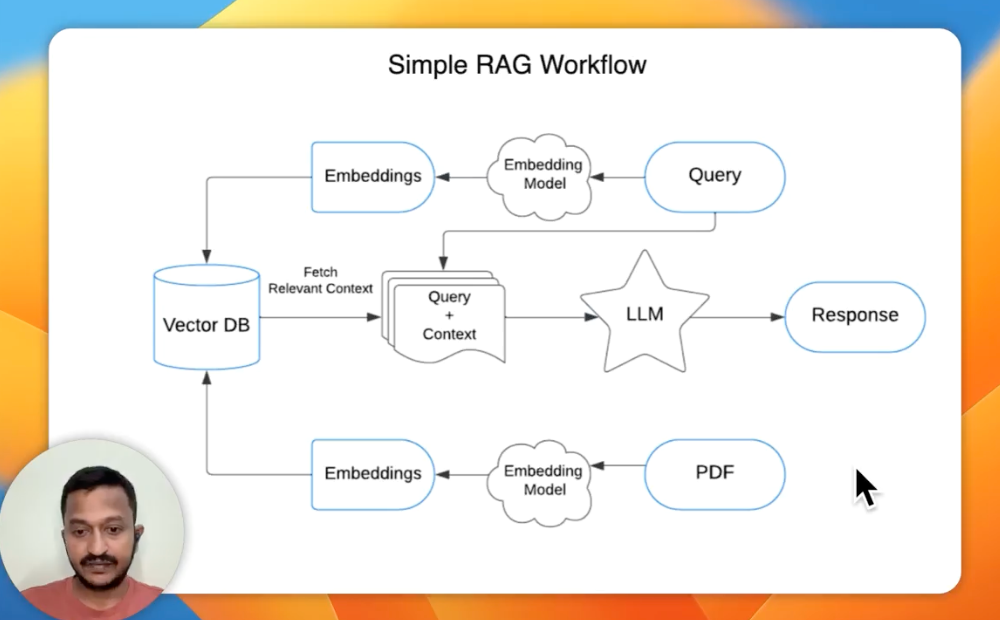
How Robust is Your RAG Setup? Let’s Evaluate:point_down:
Let’s evaluate using LlamaIndex : https://youtu.be/MP6hHpy213o
In this video, we will delve into the concept of RAG evaluation. We will evaluate the robustness of our Retrieval-Augmented Generation (RAG) workflow, focusing on the accuracy of generated responses.
We will start by understanding the importance of evaluation in RAG and see a simple RAG workflow with different stages involved. We will then understand what happens at each stage and how evaluation step fits in.
Here is the step-by-step video with tutorial: https://youtu.be/MP6hHpy213o
Production Ready RAG Pipelines
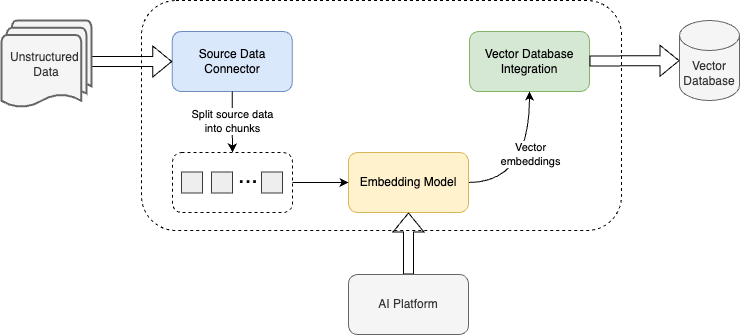
Vectorize helps you build AI apps faster and with less hassle. It automates data extraction, finds the best vectorization strategy using RAG evaluation, and lets you quickly deploy real-time RAG pipelines for your unstructured data. Your vector search indexes stay up-to-date, and it integrates with your existing vector database, so you maintain full control of your data. Vectorize handles the heavy lifting, freeing you to focus on building robust AI solutions without getting bogged down by data management.
RAG Using Llama 3.1 Model
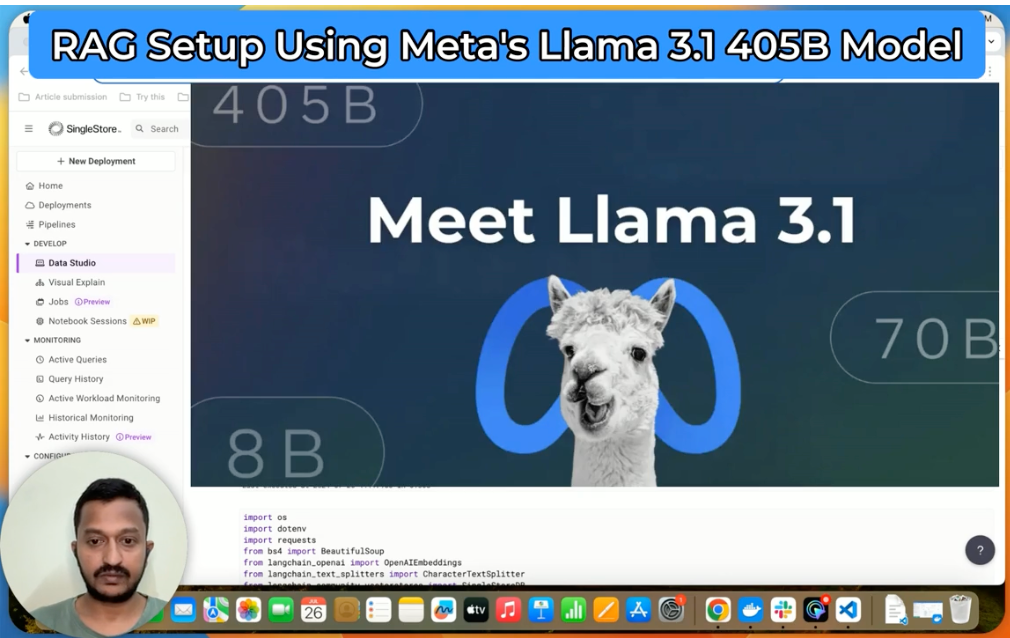
Let’s use Meta’s new Llama 3.1 model to setup RAG.
The complete setup video: https://youtu.be/aJ6KNsamdZw
Meta recently released their new set of advanced models — Llama 3.1
It has three sizes: 8B, 70B, and 405B parameters. Meta AI’s testing shows that Llama 3 70B beats Gemini and Claude in most benchmarks.
Well, this is Meta’s largest ever open source AI model, and the company claims that it has outperformed the likes of OpenAI’s GPT-4o and Anthropic’s Claude 3.5 Sonnet on some benchmarks.
I am using Llama 3.1 405B Instruct model from Fireworks AI.
You can access different models from here: https://fireworks.ai/models
More details in the video. Please refer to my video: https://youtu.be/aJ6KNsamdZw
If you are new to my videos, please subscribe:)
Verifying the Correctness of RAG Responses
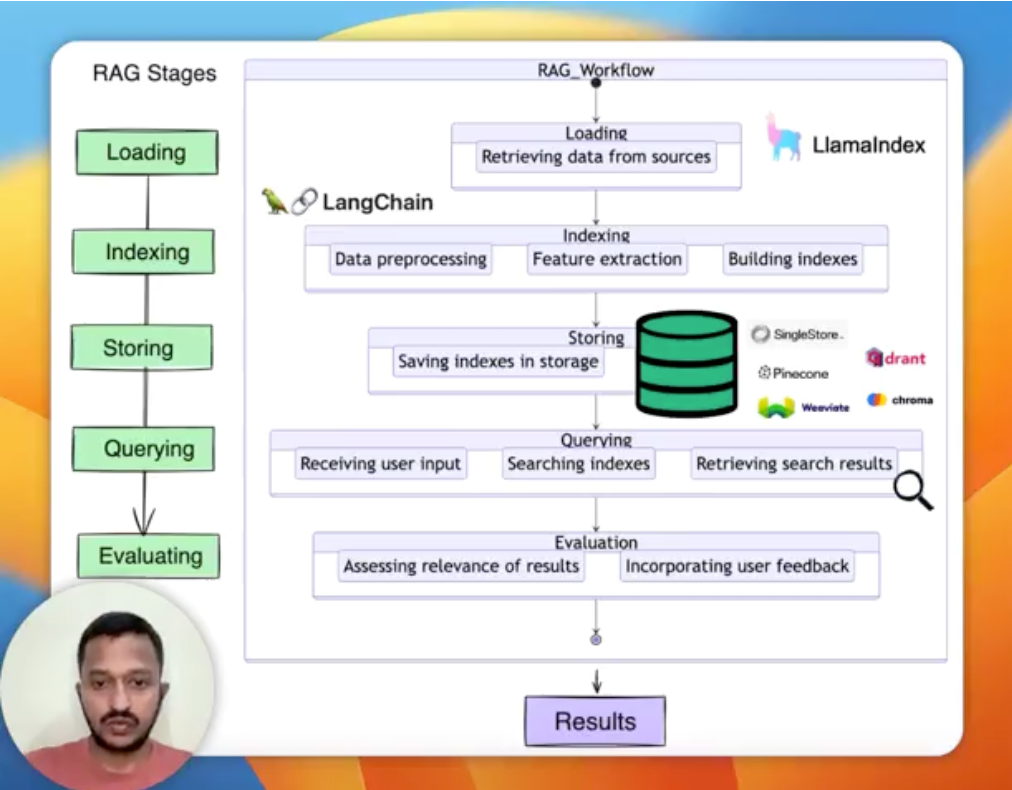
How do we verify the correctness of RAG responses?
My complete video on evaluating RAG workflow: https://youtu.be/MP6hHpy213o
Attached is a small clip of my video that talks about the different steps involved in a RAG workflow.
RAG evaluation is important because it helps ensure the effectiveness of our RAG systems. Basically, it ensures the RAG pipeline generates coherent responses, and meets end-user needs.
RAG with Knowledge Graphs
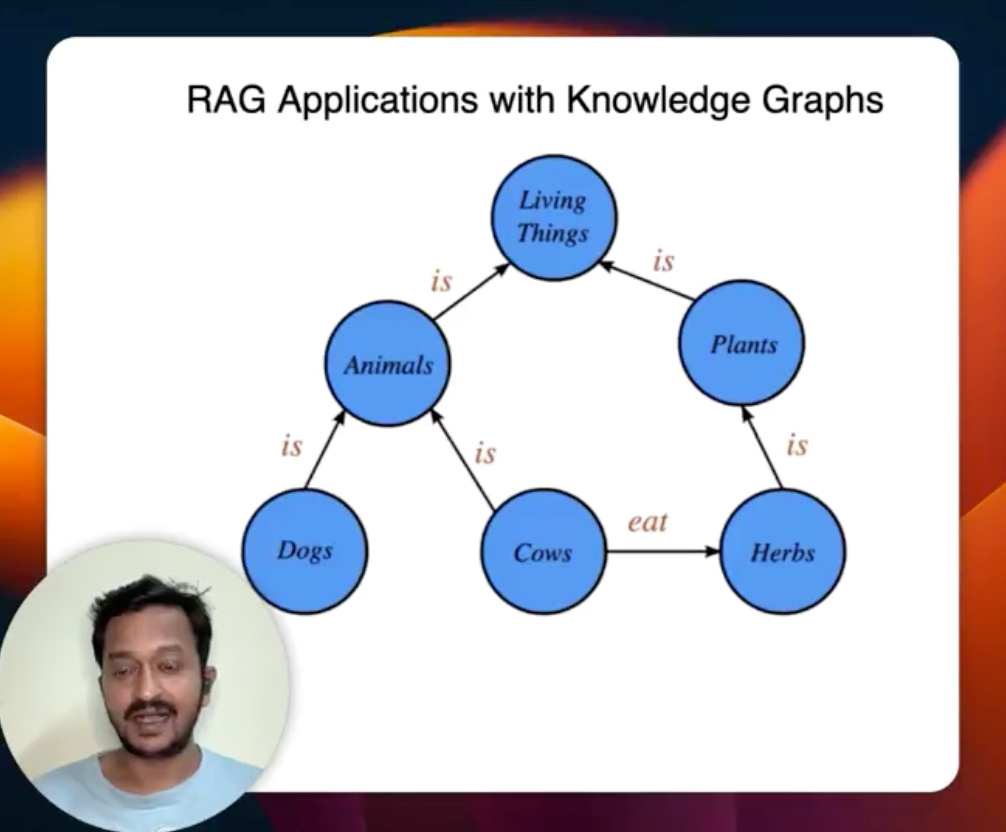
How do KnowledgeGraphs enhance our RAG applications?
Here is my complete hands-on video: https://youtu.be/rCQpQeJO59A
Once you have a knowledge graph, you can use it to perform the retrieval augmented generation (RAG). You can do the RAG without even having vectors or vector embeddings. This approach of having knowledge graphs is good for handling questions about things like aggregations and multi-hop relationships.
In the video, I have shown a tutorial on how to build a simple knowledge graph, store it in your database and retrieve the entity relationships for any given user query. The same thing can be extended to your RAG application to retrieve enhanced results/responses.
The only prerequisite to do this tutorial is SingleStore. Sign up & get a free account: https://bit.ly/SingleStoreDB
Vector RAG vs. Graph RAG
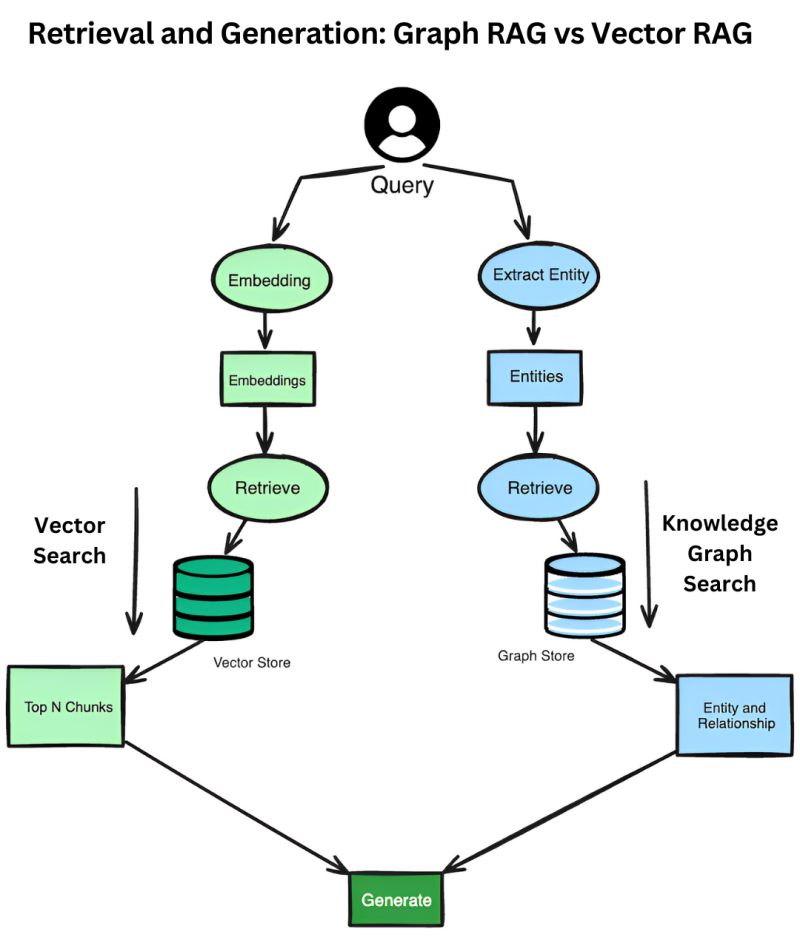
Which RAG is more superior: Graph RAG or Vector RAG?
RAG can be implemented using either a database that supports vectors and semantic search or a knowledge graph, each offering distinct advantages and methodologies for information retrieval and response generation. The goal remains the same with both approaches, to retrieve the contextually relevant data/information for the user query.
RAG with a vector database involves converting input queries into vector representations/embeddings and performing vector search to retrieve relevant data based on their semantic similarity. The retrieved documents go through an LLM to generate the responses. This approach is efficient for handling large-scale unstructured data and excels in contexts where the relationships between data points are not explicitly defined.
In contrast, RAG with a knowledge graph uses the structured relationships and entities within the graph to retrieve relevant information. The input query is used to perform a search within the knowledge graph, extracting relevant entities and their relationships.
This structured data is then utilized to generate a response. Knowledge graphs are particularly useful for applications requiring a deep understanding of the interconnections between data points, making them ideal for domains where the relationships between entities are crucial.
You don’t need a specialised database or such to do both graph RAG or vector RAG.
Well, both approaches can be possible with SingleStore, you can use it as a vector database and also for constructing and storing knowledge graphs for graph RAG.
Try SingleStore for free: https://bit.ly/SingleStoreDB
Watch my recent video on enhancing RAG applications using knowledge graphs: https://youtu.be/rCQpQeJO59A
Summary
There is no standard path to follow yet when it comes to RAG. It is all about trial and error and making sure what works best for your use case. But knowing these advanced RAG techniques is highly useful for any AI/ML/Data engineer working on the RAG pipeline.
If you liked my content, try following me on LinkedIn.
BTW, I also make videos on AI/ML/Data related topics, so you can consider subscribing to my YouTube channel.
If you are a fan of RAG and like to know more in-depth on the topic, I have an extensive e-book/guide on RAG you can download for free.
Attend the most awaited AI conference in San Francisco, happening on the 3rd of October 2024.
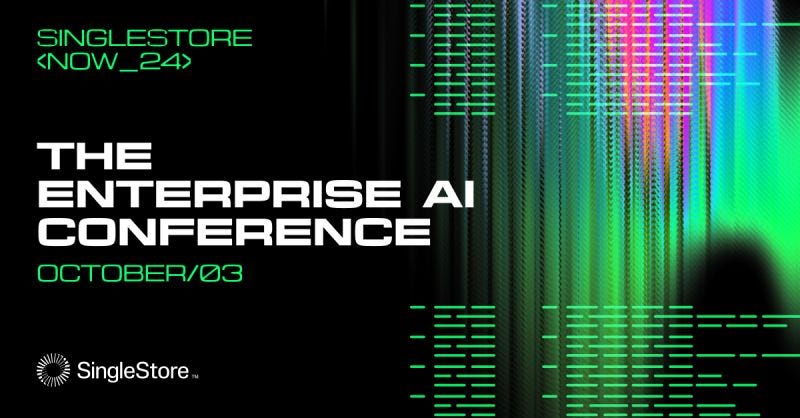
You’ll have the opportunity to hear from leaders in the field, including Jerry Liu, CEO of LlamaIndex, among others, and dive into some hands-on AI sessions.
If you are really interested in attending this conference where you will get to meet some great AI minds in the industry, let me know. I have some huge discount coupons I can share with you.
Advanced RAG Techniques: Upgrade Your LLM App Prototype to Production-Ready! was originally published in Level Up Coding on Medium, where people are continuing the conversation by highlighting and responding to this story.
This content originally appeared on Level Up Coding - Medium and was authored by Pavan Belagatti
Pavan Belagatti | Sciencx (2024-09-06T01:04:36+00:00) Advanced RAG Techniques: Upgrade Your LLM App Prototype to Production-Ready!. Retrieved from https://www.scien.cx/2024/09/06/advanced-rag-techniques-upgrade-your-llm-app-prototype-to-production-ready/
Please log in to upload a file.
There are no updates yet.
Click the Upload button above to add an update.
